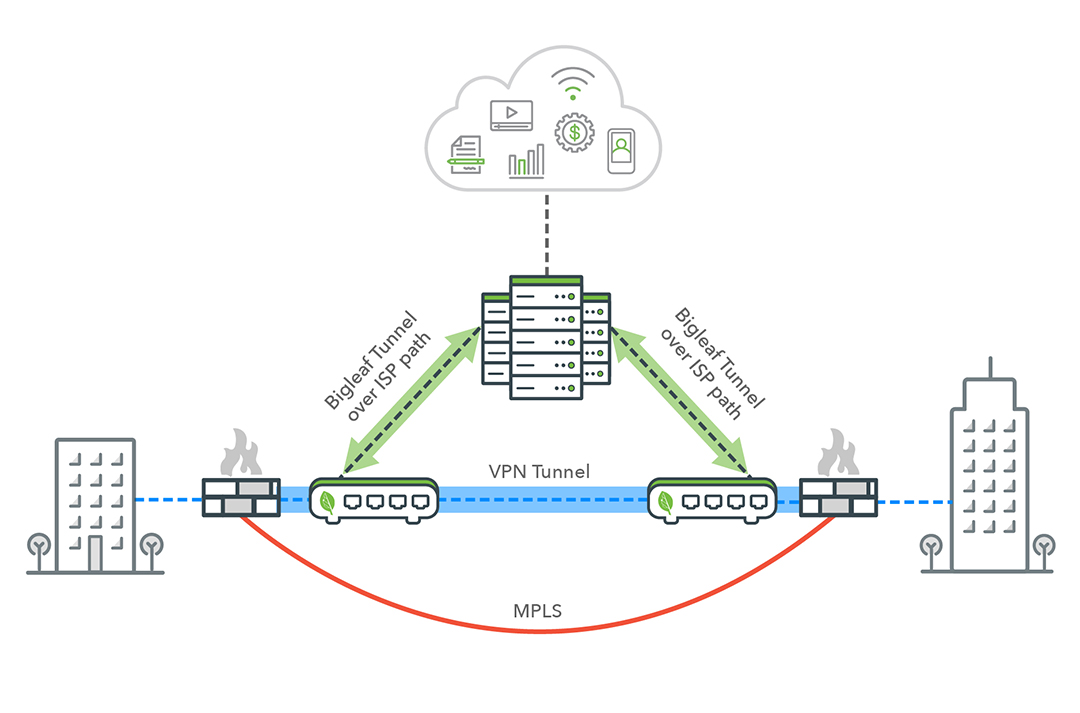Hybrid Networking with Bigleaf and MPLS: A Smart Transition Strategy
How to maintain connectivity while shifting away from MPLS
Looking for a way to improve your cloud connectivity without immediately cutting ties with MPLS? You’re not alone. Many businesses use Bigleaf to enhance internet performance while keeping their MPLS network during a transition. This hybrid approach provides flexibility, better uptime, and greater control over your traffic.
A Bigleaf + MPLS Hybrid Setup
Bigleaf’s SD-WAN solution works alongside MPLS to create a resilient network. In a typical hybrid deployment, Bigleaf tunnels route internet-bound traffic over multiple ISP paths while MPLS remains in place for site-to-site communication—or serves as a backup. This setup allows businesses to modernize without fully abandoning their private network investments.
If you’re using MPLS to connect multiple office locations, you can install Bigleaf at each site and build a VPN tunnel across the internet. Bigleaf optimizes that VPN traffic by monitoring real-time conditions and dynamically steering traffic along the best-performing path.
Under our standard deployment, the on-site router connects to multiple internet circuits—up to four. We then tunnel your traffic across those connections to a network of redundant server clusters located in major peering hubs across the U.S. From there, your traffic travels to cloud apps like Google Workspace, Zoom, or your preferred VoIP provider.
Configuration Options for Hybrid Environments
If you’ve already invested in a private network to link office locations, you might wonder whether that line can double as an additional connection. The answer is yes.
To do this, configure your MPLS to route between sites using your firewall. Then install our equipment at each location and set up a VPN tunnel between them. While it’s possible to install the solution at just one site, we recommend covering both for full traffic visibility and performance optimization across the VPN.
In this model, your firewall manages routing for both site-to-site and internet-bound traffic. While the diagram below shows MPLS as the main path between sites, you can configure it as a backup instead.
Note: Our platform requires an internet connection to build tunnels between our gateways and POPs, so MPLS isn’t routed through our router.

Two Smart Ways to Configure Your Network
You have a couple of deployment options depending on your long-term strategy:
Option 1: Keep MPLS for site-to-site, use our platform for internet traffic
In this setup, route all internet-bound data through our solution while letting MPLS handle internal traffic between sites. That way, you get performance optimization where it matters most—your internet apps—while continuing to use your private line for local traffic.
Option 2: Use our solution for everything, with MPLS as a backup
If you’re planning to move off MPLS entirely, this approach makes sense. Deploy our system at both sites and route all traffic through it—including internet and VPN traffic. The MPLS link stays in place as a backup, available via your firewall.
This strategy is ideal if you want to start benefiting from VPN today while keeping MPLS around until your contract ends.
More Resources
- Learn more about MPLS networks and why many businesses are moving to SD-WAN or VPN-based solutions.
- Explore our approach to cloud-first networking and how we prioritize application performance.
If you’d like to discuss the best setup for your environment, get in touch with our team. We’re here to help you build a better, more resilient connection to the cloud.
